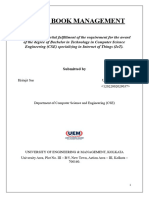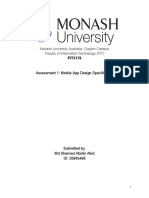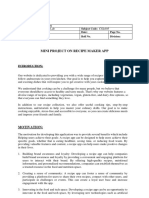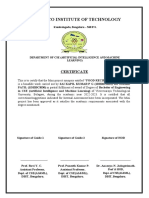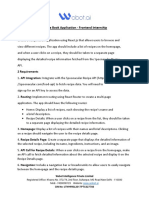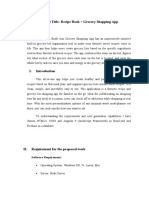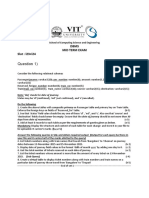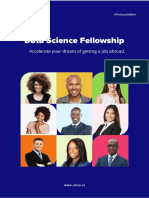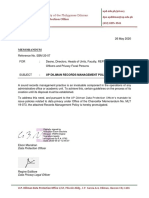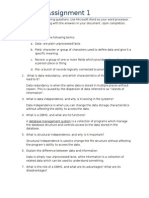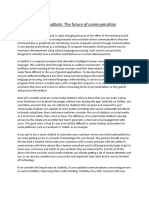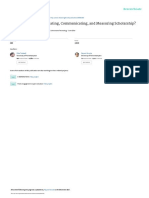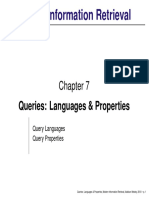A
Mini Project Report
On
“COOKBOOK RECIPE APP”
Submitted in partial fulfillment of the requirement of the University of Mumbai
for the Degree
of
Bachelor of
Engineering (Computer
Engineering)
By
Anuj Dighe
Mayur Kumawat
Chaitali Dhaije
Om Waghmare
Under the guidance of
Prof. Archana Mate
Department of Computer Engineering
Suman Educational Trust’s
Dilkap Research Institute of Engineering & Management Studies
Mamdapur, Post:Neral, Taluka:Karjat, Dist:Raigad-410101
University of Mumbai
Academic Year 2024-
1
�25
1
� Dilkap Research Institute of Engineering &
Management Studies
Department of Computer Engineering
Academic Year 2024-25
CERTIFICATE
This is to certify that
Mr. Anuj Dighe, Mr. Mayur Kumawat, Ms. Chaitali Dhaije, Mr. Om Waghmare
Sem V, T.E. Computer, has satisfactorily completed the requirements of the Mini-
Project entitled
“CookBook Recipe App”
As prescribed by the University of Mumbai Under the guidance of
Prof. Archana Mate
Guide HOD
(Prof. Archana Mate) (Dr. Prachi Gadhire)
Internal Examiner External Examiner
2
� Table of Contents
Abstract. 4
Acknowledgements 5
List of Abbreviations 6
List of Figures 6
List of Tables 6
1. Introduction. 7
1.1 Introduction. 7
1.2 Motivation 7
1.3 Problem Statement & Objectives 7
1.4 Organization of the report 8
2. Literature Survey. 9
2.1 Survey of existing system 9
2.2 Limitation Existing system or research gap 10
2.3 Mini Project Contribution 10
3. Proposed System 11
3.1 Introduction 11
3.2 Architecture / Framework 12
3.3 Algorithm and process design 12
3.4 Details of hardware and software. 15
4 Experiment and Results 16
5 Conclusion and Future work 17
3
� Abstract
The "Cookbook" Recipe App is a mobile application developed using React Native for the frontend and
MongoDB and Node.js as the backend database. This app offers a platform where users can browse a
wide variety of recipes and contribute their own recipes without the need for any login or registration
process. The purpose of this project is to provide an easy-to-use, interactive interface for users who are
passionate about cooking. The app ensures that all recipes are presented with detailed instructions,
ingredients, and images, making it a comprehensive resource for cooking enthusiasts. This report outlines
the app's features, architecture, implementation process, and the outcomes achieved.
4
� Acknowledgement
We would like to express our gratitude and appreciation to all those who gave us the possibility
to complete this project and this report. I and my team thank our head of department Dr. Prachi
Gadhire for giving us the accessory environment to acquire knowledge and skill. A special
thanks to Prof. Archana Mate, whose help, stimulating suggestions and encouragement, helped
us to coordinate our project especially in writing this report.
We would also like to acknowledge with much appreciation the crucial role of the staff of
Computer Laboratory, who gave the permission to use all required machinery and the necessary
material to complete the report special thanks goes to our friends, who gave suggestions about
the project.
5
�List of Abbreviations
UI User Interface
JSON JavaScript Object Notation
List of Figures
Figure 1 Architecture Diagram of the Cookbook App
Figure 2 React Native App Screenshot
List of Tables
Table 1 Comparison of Existing Recipe Apps
Table 2 Cookbook Recipe App Features
6
� Introduction
1.1 Introduction:
The Cookbook Recipe App is designed to cater to users who are passionate about cooking and wish to
explore a variety of recipes with ease. With a simple and user-friendly interface, the app enables users to
search for recipes based on ingredients or recipe names, view detailed step-by-step instructions, and add
their own recipes to the collection. The app's primary focus is on providing essential recipe features
without requiring users to create an account, ensuring quick access to the recipes they need. This project
aims to create an intuitive platform that brings a vast collection of recipes to users' fingertips while
allowing them to contribute to the growing recipe database.
1.2 Motivation:
The motivation for developing this app came from the need for a simplified recipe application that doesn't
require users to sign up or log in to access basic recipe functionalities. Many existing apps require
registration, making them cumbersome for users who want to quickly find or share recipes.
1.3 Problem statement & Objectives
Most recipe apps available in the market require users to register or log in before accessing their core
features. This can be a barrier for users who wish to quickly find recipes or explore new dishes without
going through lengthy registration processes. Additionally, many apps clutter the user experience with
excessive features such as social sharing, comments, and user profiles, which can be overwhelming for
those who simply want to browse recipes. The Cookbook Recipe App addresses this issue by providing a
streamlined experience focused on the core functionalities: searching for recipes, viewing ingredients, and
adding new recipes, without any login or registration requirements.
7
�1.4 Organization of the Report
This report is organized as follows:
Chapter 2 presents the literature survey, including existing systems and identified gaps.
Chapter 3 describes the proposed system, including its architecture and process design.
Chapter 4 outlines the experiments conducted and the results obtained.
Chapter 5 concludes the report and suggests potential future work.
8
� Literature Survey
2.1. Survey of Existing Sytem
A detailed survey was conducted to analyze the existing recipe apps and identify their strengths and
shortcomings. Several apps, such as Yummly, Allrecipes, and Tasty, offer comprehensive recipe databases
but require user registration for saving favorite recipes or contributing new ones. The survey revealed that
many users prefer apps that offer simple, unrestricted access to recipes without the need for an account.
Additionally, the cluttered interfaces and multiple features found in these apps can often overwhelm users
looking for a basic recipe browsing experience. This observation guided the development of the Cookbook
Recipe App, focusing on providing an uncluttered, registration-free experience.
9
� 2.2. Limitations of Existing Systems or Research Gap
Registration Requirement: Most apps demand user login/registration, which is often seen as a hurdle.
Overcomplicated Features: Many apps include complex features that clutter the interface and reduce
usability.
Limited Offline Access: Some existing apps do not offer offline access or have limited data when
offline.
2.3. Mini Project Contribution
The Cookbook Recipe App addresses the identified gaps by:
Providing unrestricted access to recipe search and viewing without requiring user registration.
Offering an easy-to-navigate interface with only essential features.
Allowing users to add recipes directly to the MongoDB database, ensuring a growing collection of user-
contributed content.
10
� Proposed System
3.1 Introduction
The proposed system is a mobile application developed using React Native and MongoDB. The app allows
users to search for recipes, view instructions, and contribute their own recipes. It is designed to be
lightweight, responsive, and user-friendly.
3.2. Architecture/Framework
The app follows a client-server architecture, with the React Native front end acting as the client and
MongoDB as the backend. The components include:
Front-end (React Native): Handles the user interface and interactions.
Backend (MongoDB): Manages data storage and retrieval.
API Layer (Node.js with Express): Facilitates communication between the frontend and MongoDB
for CRUD operations.
11
�3.3 Algorithm and Process Design
The app employs CRUD operations to manage recipes:
1. Search Algorithm: The user inputs a search query, which is sent to the backend to retrieve
relevant recipes from MongoDB based on keywords.
2. Recipe Viewing: When a recipe is selected, the app fetches the details from MongoDB, displaying
the ingredients and steps.
3. Adding Recipes: Users can input recipe details, which are sent to MongoDB through the API.
Process Flow:
User inputs -> API call -> Database query -> Data retrieval/display
Source Code:
12
�13
�14
�3.4. Details of Hardware and Software:
Hardware Requirements:
A computer with at least 4GB RAM for development
Android device/emulator for testing
Software Requirements:
React Native: For building the app’s user interface
Node.js: For setting up the backend server
MongoDB: Database management system.
Visual Studio Code: IDE for coding
Axios: For handling API requests
15
� Experiment and Results
During the development phase, the app was tested for functionality, responsiveness, and performance:
Functionality Testing: Verified that all modules (search, view, and add recipe) functioned
correctly.
Usability Testing: Ensured the user interface was intuitive and easy to navigate.
Performance Testing: Evaluated the app's performance with a large dataset to ensure efficient
data retrieval from the MongoDB database.
Results:
The search functionality provided accurate results based on the entered keywords.
Recipe details were displayed correctly, and adding new recipes to the database was successful.
The app performed efficiently without noticeable lag, even with increased data entries.
16
� Conclusion and Future Work
The Cookbook Recipe App successfully meets its objectives by providing a user-friendly platform for
searching, viewing, and adding recipes without requiring login or registration. The app demonstrates
effective use of React Native for front-end development and MongoDB for backend data management.
Future Work:
Offline Access: Implementing offline storage for recipes to allow access without an internet
connection.
Enhanced Search: Integrating advanced search filters, such as cuisine type or preparation time.
Recipe Rating: Allowing users to rate recipes, helping others find the most popular dishes.
17


